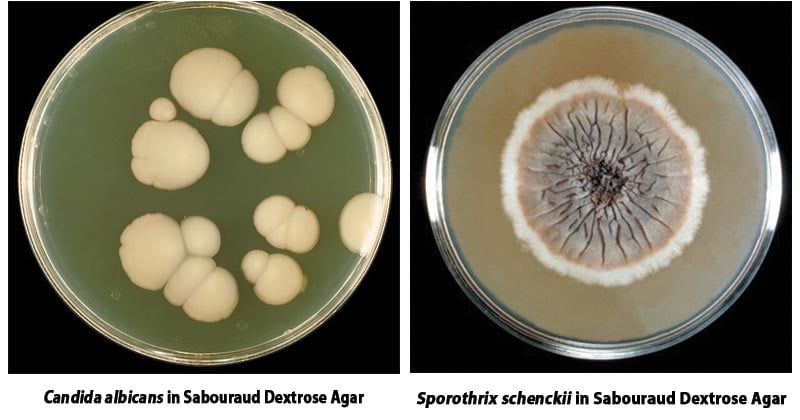Sabouraud Dextrose Agar or SDA was formulaed by Raymond Sabouraud in 1892. Sabouraud Dextrose Agar is used for the cultivation of fungi (yeasts, molds), particularly useful for the fungi associated with skin infections. This medium is also employed to determine microbial contamination in food, cosmetics, and clinical specimens. The pH is adjusted to approximately 5.6 in order to enhance the growth of fungi, especially dermatophytes, and to slightly inhibit bacterial growth in clinical specimens. Antibacterial agents can also be added to augment the antibacterial effect. Chloramphenicol, gentamicin, and tetracycline are selective agents added to inhibit the bacterial overgrowth of competing microorganisms while permitting the successful isolation of fungi and yeasts.
Interesting Science Videos
Principle of Sabouraud Dextrose Agar (SDA)
Sabouraud Dextrose Agar contains digests of animal tissues (peptones) which provide a nutritious source of amino acids and nitrogenous compounds for the growth of fungi and yeasts. Dextrose is added as the energy and carbon source. Agar is the solidifying agent. Chloramphenicol and/or tetracycline may be added as broad-spectrum antimicrobials to inhibit the growth of a wide range of gram-positive and gram-negative bacteria. Gentamicin is added to further inhibit the growth of gram-negative bacteria. The pH is adjusted to approximately 5.6 in order to enhance the growth of fungi, especially dermatophytes, and to slightly inhibit bacterial growth in clinical specimens. High dextrose concentration and low pH favor fungal growth and inhibit contaminating bacteria from test samples.
Composition of Sabouraud Dextrose Agar (SDA)
| Ingredients | Gms/Liter |
| Dextrose | 40.0 |
| Peptone | 10.0 |
| Agar | 15.0 |
Final pH ( at 25°C) 5.6±0.2
Preparation of Sabouraud Dextrose Agar (SDA)
- Suspend 65 g of the medium in one liter of distilled water.
- Heat with frequent agitation and boil for one minute to completely dissolve the medium.
- Autoclave at 121° C for 15 minutes.
- Cool to 45 to 50°C and pour into petri dishes or tubes for slants.
Result Interpretation on Sabouraud Dextrose Agar (SDA)

| Fungi | Colony morphology |
| Candida albicans | Pasty opaque slightly domed, smooth, and cream or white colonies |
| Aspergillus flavus | Yellow-green powdery on front and pale yellowish on reverse |
| Aspergillus niger | The initial growth is white, becoming black later on giving a “salt and pepper appearance” which results from darkly pigmented conidia borne in large numbers on conidiophores and reverse turning pale yellow |
| Aspergillus fumigatus | Bluish-green powdery colonies on front and pale yellow on the reverse. |
| Trichosporon mucoides | White to cream, yellowish, wrinkled |
| Geotrichum candidum | White to cream-colored, flat with aerial mycelium |
Uses of SDA
- SDA is primarily used for the selective cultivation of yeasts, molds and aciduric bacteria.
- The medium is often used with antibiotics for the isolation of pathogenic fungi from material containing large numbers of other fungi or bacteria.
- This medium is also employed to determine microbial contamination in food, cosmetics, and clinical specimens.
Limitations of SDA
- Some strains may be encountered that grow poorly or fail to grow on this medium.
- Antimicrobial agents added into a medium to inhibit bacteria may also inhibit certain pathogenic fungi.
- Avoid overheating a medium with an acidic pH, this may result in a soft medium.
- For identification, organisms must be in pure culture.
- Morphological, biochemical, and/or serological tests should be performed for final identification.
- It does not promote the conidiation of filamentous fungi.

How to make SDA with Chloramphenicol?
when we should add Chloramphenicol before or after autoclave?
The amount of the inhibitory agents ( chloramphenicol and tetracycline) and at what stage of preparation is added in the SDA
How long are the plates good for after making?
Do you have any available references?
Could anyone tell me which test methods support the SDA method for food analysis